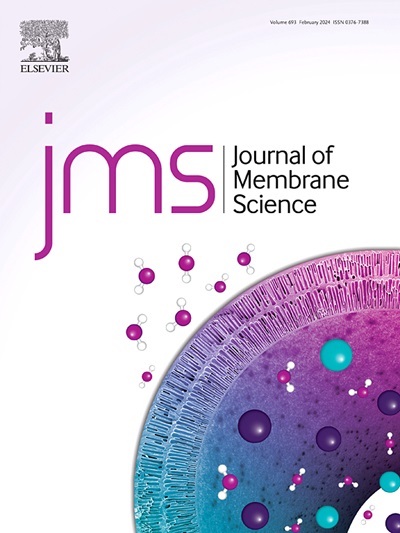Micro-nanobubbles to alleviate ultrafiltration membrane fouling for biogas slurry concentration and nutrient enrichment: Performance and molecular mechanisms
IF 8.4
1区 工程技术
Q1 ENGINEERING, CHEMICAL
引用次数: 0
Abstract
This study evaluated the performance of micro-nanobubbles (MNBs) to mitigate membrane fouling during ultrafiltration (UF) concentration of chicken manure biogas slurry. Molecular characteristics of organic foulants in biogas slurry were examined to elucidate the underlying mechanisms. Results showed that MNBs pre-treatment of biogas slurry could reduce membrane fouling and improve fouling reversibility during subsequent UF concentration using oxygen as the gas source. MNBs increased the molecular number of dissolved organic matter (DOM) and thermodynamic instability, and reduced the particle size of biogas slurry. As a result, organic foulants, mainly including lignin, lipids, and protein/amino sugar, rapidly attached onto the membrane surface to form a thick but highly reversible fouling layer. Irreversible foulants mainly caused by inorganic foulants were alleviated due to MNB pretreatment to decrease carboxylic groups in biogas slurry to break the interaction between DOM and cations in inorganic foulants. The weakened cation-DOM interaction could be related to the reduction in calcium bridging with humic-like substances as well as electrostatic shielding between potassium and humic-like/fulvic-like substances. As such, the water flux and its recovery after regular cleaning were enhanced by 58.1% and 19.6% in UF operation, respectively, when MNBs was used for biogas slurry pre-treatment.
微纳泡缓解超滤膜污染对沼液浓缩和营养物富集的影响:性能和分子机制
研究了微纳气泡(MNBs)对鸡粪沼液超滤(UF)处理过程中膜污染的影响。研究了沼液中有机污染物的分子特征,探讨了其形成机理。结果表明,沼液预处理MNBs可减少膜污染,提高后续氧源超滤浓缩过程中膜污染的可逆性。MNBs增加了溶解有机物(DOM)的分子数和热力学不稳定性,减小了沼液的粒径。因此,主要包括木质素、脂类、蛋白质/氨基糖等有机污染物迅速附着在膜表面,形成一层厚但高度可逆的污染层。通过MNB预处理减少沼液中的羧基,打破无机垢中DOM与阳离子的相互作用,减轻了无机垢引起的不可逆污染。阳离子- dom相互作用减弱可能与钙与腐植酸样物质桥接减少以及钾与腐植酸样/黄腐酸样物质之间的静电屏蔽有关。因此,采用MNBs对沼液进行预处理后,超滤操作的水通量和定期清洗后的水回收率分别提高了58.1%和19.6%。
本文章由计算机程序翻译,如有差异,请以英文原文为准。
求助全文
约1分钟内获得全文
求助全文
来源期刊

Journal of Membrane Science
工程技术-高分子科学
CiteScore
17.10
自引率
17.90%
发文量
1031
审稿时长
2.5 months
期刊介绍:
The Journal of Membrane Science is a publication that focuses on membrane systems and is aimed at academic and industrial chemists, chemical engineers, materials scientists, and membranologists. It publishes original research and reviews on various aspects of membrane transport, membrane formation/structure, fouling, module/process design, and processes/applications. The journal primarily focuses on the structure, function, and performance of non-biological membranes but also includes papers that relate to biological membranes. The Journal of Membrane Science publishes Full Text Papers, State-of-the-Art Reviews, Letters to the Editor, and Perspectives.
 求助内容:
求助内容: 应助结果提醒方式:
应助结果提醒方式:


